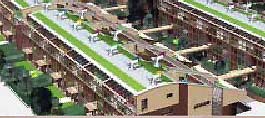Planning Advice Note 67: housing quality
Planning Advice Note (PAN) 67 explains how Designing Places should be applied to new housing.
This document is part of a collection
Planning Advice Note PAN 67 Housing Quality
Successful places
The contribution of urban design to city and town centre regeneration is widely recognised. In such settings the intensity of urban life is seen as a positive quality, and maintaining a robust urban fabric is accepted as a way of supporting that intensity. But a great deal of new housing is in suburban settings; on the edge of settlements; or in rural areas. These places need high standards of design just as much as town and city centres.
Designing Places identifies the qualities that we find in places that are socially, economically and environmentally successful. Those qualities should be the concern of everyone who is planning or developing housing. More immediately, they are also close to the heart of anyone who is looking for somewhere to live.
Certainly location, size and price are among the first things we look for in a new home. But many people also want to live in a place that has a distinct identity, rather than one that could be anywhere. They want personal comfort, security and peace of mind. They may want their home to be accessible without having always to use a car. They may want a home that will prove adaptable as their household and other circumstances change. For example, people increasingly want to have the option of working from home, and they want a home that makes good use of resources, even if only because they pay the heating bills. Some aspects of the resource use in housing development are planning matters - such as layout. Others are matters for the building standards.
Every development should be part of a place with a mix of uses. This does not mean that housing should always be peppered with other uses, or even that every development proposal should have more than one use. But every development should be planned and designed as a part of a place that does more than just house people.
The variety will help the neighbourhood support different types of activity at different times of the day, and to adapt to changing circumstances without having to be completely rebuilt. The conditions for a successful mix of uses are likely to include a range of factors, only some of which are subject to planning control. They include diversity of ownership; appropriate tenure; location on streets that are sufficiently busy; sufficient density; buildings with a flexible form, and a mix of uses that are compatible.
Housing quality
Successful places are:
- Distinctive
- Safe and pleasant
- Easy to get to and move around
- Welcoming
- Adaptable
- Resource efficient
place
every development should be planned as part of a place
that does more than just house people
Distinctive
Whiteinch Cross, Glasgow

Eaves level lighting installations provide a distinctive landmark for the area at night.
Safe & pleasant
Crookfur House, East Renfrewshire

Well thought out sheltered housing which provides security, as well as being modern and attractive.
Easy to get around
Ardler, Dundee

New road principles have been established to ensure the development is accessible and easy to get around.
Welcoming
Glenoaks, Glasgow

Family housing designed on a scale to create a welcoming and pleasant environment.
Adaptable
Craigash Quadrant, East Dunbartonshire

Housing which can be adapted to suit the occupants as they age. Extra wide doors and level thresholds make the houses more accessible.
Resource efficient
BedZed, Borough of Sutton

Large scale carbon neutral development incorporating a range of environmental features. All homes are south facing and insulated photovoltaic panels on the roof produce clean electricity.
Contact
There is a problem
Thanks for your feedback